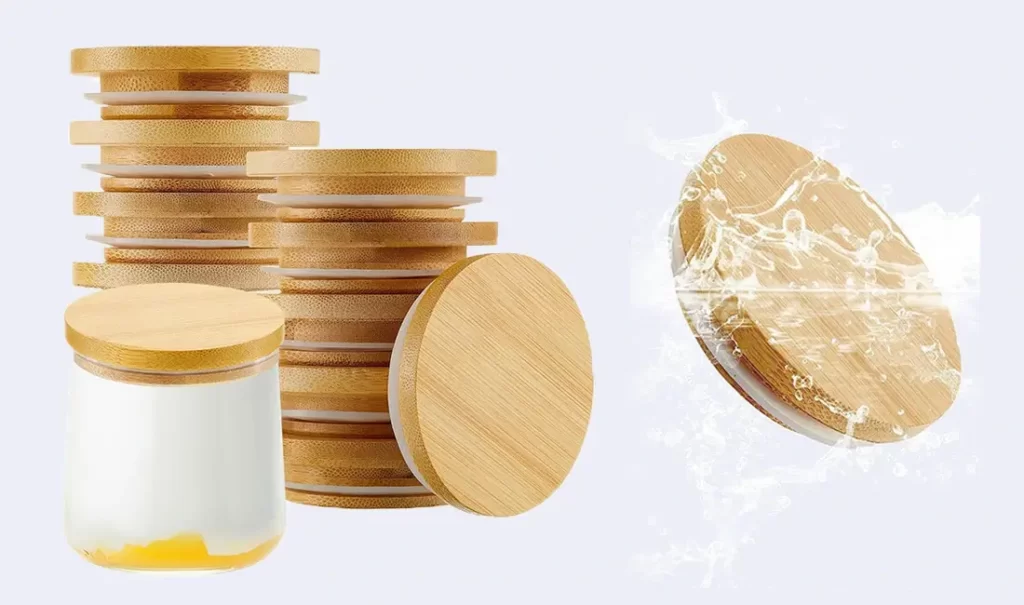With the increasing focus on environmental conservation and the emergence of unique bamboo product designs, bamboo products have gained immense popularity in the market. However, there is still a lack of awareness about the specific features of bamboo lid products, leading to various queries, such as whether bamboo lids are safe to use in dishwashers. In this article, I will guide you through the complete production process of bamboo lids, starting from the very beginning, to provide a comprehensive understanding of the subject. Let’s get started!

1. Characteristics of Bamboo Material
Bamboo is a versatile and natural material known for its various positive qualities. It is a type of grass that exhibits impressive strength and durability, making it comparable to many hardwoods. Despite its appearance, bamboo is not to be underestimated due to its high tensile strength, making it suitable for construction and engineering applications.

One of the key advantages of bamboo is its rapid growth rate. Some bamboo species can grow several feet in just a day, making it a highly renewable resource. Its fast growth allows for more frequent harvesting compared to traditional hardwoods, which can take decades to mature.
From an environmental standpoint, bamboo is considered eco-friendly and sustainable. Its quick growth and ability to regenerate after harvesting make it an attractive alternative to slow-growing hardwood trees. Bamboo cultivation typically requires minimal chemical inputs, reducing its impact on the environment.
Bamboo’s natural flexibility is another noteworthy feature. This characteristic makes it suitable for applications where some bending or curvature is necessary
In terms of appearance, bamboo has a unique and natural beauty. Its grain patterns and warm color contribute to its aesthetic appeal, making it a popular choice for various decorative and artistic uses.
Bamboo also exhibits some resistance to moisture, pests, and decay, thanks to its natural anti-fungal and antibacterial properties.
Bamboo is a good raw material for making lids, and it is worth encouraging and promoting from the point of view of environmental protection.
2. The Production Process of Bamboo Lids
Bamboo Harvesting: The production process begins with the harvesting of mature bamboo stalks. Bamboo is typically harvested when it reaches the appropriate age and size for the specific lid requirements. It’s crucial to select bamboo from sustainable and responsibly managed sources to ensure environmental conservation.
Cleaning and Drying: After harvesting, the bamboo stalks are cleaned to remove any dirt, debris, or impurities. They are then carefully dried to reduce their moisture content. Proper drying helps prevent mold and ensures the bamboo’s stability during the manufacturing process.
Slicing and Cutting: The dried bamboo stalks are sliced into smaller sections to match the desired lid size. These sections are then cut into circular shapes using various cutting tools or machines. The diameter of the circular pieces depends on the dimensions required for the specific lids being produced.
Carving and Shaping: The circular bamboo pieces are further refined by carving and shaping them to achieve the desired lid design. Skilled artisans may use traditional hand tools or modern machinery to carefully carve and shape the bamboo pieces, ensuring precision and uniformity.
Sanding and Smoothing: To achieve a smooth and polished surface, the bamboo lids undergo sanding. This step involves the use of sandpaper or sanding machines to remove any rough edges, splinters, or imperfections on the lid’s surface.
Finishing and Treatment: Depending on the intended use and design preferences, the bamboo lids may undergo various finishing treatments. Some lids are left in their natural state, showcasing the beauty of the bamboo’s grain and color, while others may be stained or coated with protective finishes to enhance their appearance and durability.
Quality Control: Throughout the production process, strict quality control measures are implemented to ensure that the bamboo lids meet the required standards. This includes checking for size consistency, smoothness, and any defects that need to be addressed.
Packaging and Distribution: Once the bamboo lids pass quality control checks and meet the required standards, they are packaged for distribution. Packaging materials are chosen to protect the lids during transportation and storage.
Maybe it’s not easy for you to understand, so I prepared a video to get a more intuitive understanding of the whole production process of a bamboo lid. Please watch the following video
3. Advantages and Disadvantages of Bamboo Lids
Advantages:
Eco-Friendly: Bamboo wooden lids are considered environmentally friendly as bamboo is a highly renewable resource. It grows quickly and can be harvested without harming the entire plant, making it a sustainable choice compared to traditional hardwoods.
Lightweight: Bamboo lids are relatively lightweight, which makes them easy to handle and transport. This characteristic is particularly beneficial for items like food containers, jars, and canisters, where the lid’s weight can affect usability.
Attractive Appearance: Bamboo has a natural and warm aesthetic appeal, with unique grain patterns and pleasing color. This makes bamboo wooden lids visually appealing, enhancing the overall look of the container or vessel they cover.
Natural Moisture Resistance: Bamboo contains natural properties that make it resistant to moisture and humidity. This feature is advantageous when using bamboo lids for containers that store items sensitive to moisture, such as food products or bath products.
Biodegradable: Bamboo lids are biodegradable, meaning they can naturally break down over time without causing harm to the environment. This makes them a preferable choice over non-biodegradable materials like plastics.
Disadvantages:
Limited Durability: While bamboo is relatively strong, it is not as durable as some hardwoods. Over time, bamboo lids may show signs of wear and tear, especially when exposed to frequent use or harsh conditions.
Vulnerable to Pests and Decay: Despite its natural resistance to moisture, bamboo can still be susceptible to pests like termites and decay if not properly treated or maintained. Proper finishing and care are essential to prolong the lifespan of bamboo wooden lids.
Limited Heat Resistance: Bamboo wooden lids may not withstand high temperatures as well as metal or certain plastics. Exposing them to extreme heat can cause warping or damage, which can be a concern when using them in hot or cooking-related applications.
Variation in Quality: The quality of bamboo wooden lids can vary based on the source of the bamboo, the manufacturing process, and the finishing techniques used. Lower-quality bamboo lids may have inconsistencies in size, shape, or finish.
Cost: In some cases, bamboo wooden lids can be more expensive compared to lids made from other materials, such as plastic or metal. The cost can vary depending on the quality and craftsmanship of the lids.
4. Frequently Asked Questions about Bamboo Lids
Are bamboo lids safe in the fridge?
Yes, bamboo lids are generally safe to use in the fridge. Bamboo is a natural material and tends to be more resistant to temperature changes compared to some other materials. However, it’s essential to ensure that the bamboo lid is properly sealed to the container to maintain food freshness and prevent any potential leaks or spills.
How do you clean bamboo jar lids?
To clean bamboo jar lids, follow these steps:
a. Remove any food residue or particles from the lid using a soft brush or cloth.
b. Mix a mild detergent with warm water and use a sponge or cloth to wipe the surface of the lid.
c. Avoid soaking the bamboo lid in water for an extended period as excessive moisture can damage the bamboo. Instead, quickly wipe it down with a damp cloth and dry it immediately.
Do bamboo lids get moldy?
With proper care, bamboo lids are less likely to get moldy compared to lids made from materials like wood. However, if bamboo lids are exposed to excessive moisture or not cleaned and dried properly, mold can develop. Regularly cleaning and ensuring the lids are dry can help prevent mold growth.
Are bamboo lids better than plastic?
Bamboo lids have some advantages over plastic lids. Bamboo is a renewable and biodegradable material, making it more environmentally friendly than most plastics. It’s also durable and can last for a long time with proper care. However, plastic lids are often more airtight, which may offer better food preservation in some cases. The choice between bamboo and plastic lids depends on personal preferences and specific use cases.
Are bamboo lids microwave safe?
Most bamboo lids are not microwave safe. Microwaving bamboo lids can cause them to dry out, crack, or deform due to the heat. To avoid any issues, remove the bamboo lid before placing the container in the microwave and use a microwave-safe alternative to cover the container if necessary.
How do you get the smell out of bamboo lids?
To remove odors from bamboo lids, try the following steps:
a. Clean the lid thoroughly using a mixture of mild detergent and warm water.
b. Rinse the lid with clean water and pat it dry with a towel.
c. Place the lid in a well-ventilated area and let it air out for a few hours or overnight.
Can you freeze glass containers with bamboo lids?
It’s generally safe to freeze glass containers with bamboo lids. However, there are a few important considerations:
a. Ensure the container is freezer-safe and designed to withstand freezing temperatures.
b. Leave enough headspace in the container to account for expansion as the contents freeze.
c. Avoid extreme temperature changes, such as transferring a frozen container directly from the freezer to a hot oven, as this can damage the bamboo lid.
d. Thaw the container gradually, preferably in the refrigerator, to prevent any potential damage to the bamboo lid due to rapid temperature changes.
Always refer to the specific manufacturer’s instructions and recommendations for using glass containers with bamboo lids in the freezer.
5. Cleaning and Maintenance Methods for Bamboo Lids
Cleaning and maintaining bamboo lids is essential to preserve their appearance and functionality. Here are some steps to clean and care for bamboo lids:
Regular Cleaning: For day-to-day cleaning, use a soft, damp cloth or sponge to wipe the surface of the bamboo lid. Avoid using abrasive materials or harsh chemicals that could damage the bamboo.
Mild Soap Solution: For more thorough cleaning, prepare a mild soap solution using a few drops of dish soap mixed with warm water. Dip a soft cloth or sponge into the solution and gently clean the bamboo lid, removing any stains or grime. Afterward, wipe off any soap residue with a clean damp cloth.
Avoid Soaking: Do not soak bamboo lids in water or submerge them fully. Excessive exposure to water can cause warping or swelling of the bamboo, affecting the lid’s fit and appearance.
Drying: After cleaning, ensure the bamboo lid is completely dry before using or storing it. Use a dry cloth to remove any excess moisture, and then allow it to air dry in a well-ventilated area.
Oil Treatment: Periodically, you can apply a food-safe oil, such as mineral oil or coconut oil, to the bamboo lid to help maintain its luster and prevent drying out. Apply a small amount of oil with a clean cloth, and rub it into the surface of the lid. Wipe off any excess oil.
Avoid Extreme Temperatures: Keep bamboo lids away from extreme temperatures, both hot and cold. Avoid placing them near stoves, ovens, or other heat sources, as this can cause warping. Similarly, avoid exposing them to freezing temperatures.
By following these cleaning and maintenance tips, you can extend the lifespan of your bamboo lids and keep them looking beautiful and functional for a long time.
6. Bamboo Lid Glassware Buying Guide
If you’re looking to purchase glassware with bamboo lids, here’s a helpful buying guide to ensure you make the right choice:
- Purpose and Usage:
Determine the purpose of the glassware with bamboo lids. Will it be used for food storage, beverage containers, or other purposes? Different designs and features may be suitable for specific uses.
- Quality of Glass:
Check the quality of the glassware. Opt for tempered or borosilicate glass, as they are more resistant to heat and less likely to break compared to regular glass.
- Bamboo Lid Quality:
Inspect the bamboo lids for quality. Look for smooth finishes, even coloring, and no visible defects. Ensure the lids fit securely on the glass containers to create an airtight seal.
- Lid Design and Functionality:
Consider the lid design and functionality. Some bamboo lids may have silicone gaskets for enhanced airtightness, while others may have simple bamboo tops without seals.
- Size and Capacity:
Choose glassware with the right size and capacity to meet your needs. Consider the volume you require for storage or serving purposes.
- Safety Features:
Check for safety features such as BPA-free materials and food-grade certifications to ensure that the glassware and bamboo lids are safe for use with food and beverages.
- Cleaning and Maintenance:
Consider the ease of cleaning and maintenance. Glassware and bamboo lids that are dishwasher-safe or easy to hand wash will be more convenient for everyday use.
- Environmental Impact:
Opt for glassware and bamboo lids from environmentally responsible brands that prioritize sustainable sourcing and eco-friendly practices.
- Brand Reputation:
Research the reputation of the brand or manufacturer. Look for reviews and feedback from other buyers to gauge the quality and reliability of the product.
- Supplier Recommendation:
For glassware with bamboo lids, we recommend considering “TULIP TREE JARS,” a reputable supplier with over 10 years of experience in providing quality glassware products. They have a proven track record of delivering durable and stylish glass containers with bamboo lids.
- Price and Value:
Compare prices across different brands and products, but also consider the overall value. Cheaper options may not always offer the same durability and quality as slightly higher-priced ones.
- Packaging and Shipping:
Check the packaging and shipping options to ensure the glassware and bamboo lids will arrive in good condition. Consider purchasing from sellers with secure packaging practices.
- Warranty and Return Policy:
Inquire about the warranty and return policy in case of any defects or damages upon receipt of the product.
By following this buying guide and considering “TULIP TREE JARS” as a trusted supplier, you can make an informed decision when purchasing glassware with bamboo lids that meets your needs, preferences, and values. Happy shopping!



